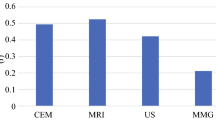Abstract
Background
Accurate assessment of tumor size for patients with breast cancer undergoing re-excision following breast-conserving therapy is important for appropriate staging and adjuvant treatment. We investigated the accuracy of additive vs. nonadditive size assessment in determining final tumor stage.
Methods
Patients with infiltrating carcinoma in the initial excision and in at least one additional re-excision (re-excision positive; n=89) had tumor size assessed with additive and nonadditive techniques. This group was compared with patients undergoing re-excision but without identifiable residual carcinoma (re-excision negative; n=105) regarding rates of lymph node (LN) metastasis.
Results
The re-excision positive patients had a different median final tumor size depending on the size assessment technique used (nonadditive: 1.8 cm; additive:3.0 cm;P<.0001). Both groups of patients had a median tumor size consistent with T1c staging in nonadditive size assessment. However, re-excision positive patients had a significantly higher incidence of LN metastasis (P<.05) than did re-excision negative patients. Both groups were then separated into T1 and T2 stages and the LN metastasis rates were assessed. Compared with nonadditive size assessment, additive size assessment distributed re-excision positive patients into T stages whereby the LN metastasis rates more closely approximated those of re-excision negative patients (T1, 3% vs. 6% difference; T2, 4% vs. 13% difference).
Conclusions
With regard to LN metastasis, staging for patients with residual invasive carcinoma in re-excision specimens is more accurate with additive tumor size assessment.
Similar content being viewed by others
References
Carter CL, Allen C, Henson DE. Relation of tumor size, lymph node status, and survival in 24,740 breast cancer cases.Cancer 1989;63:181–7.
Abner AL, Collins L, Peiro G, et al. Correlation of tumor size and axillary lymph node involvement with prognosis in patients with T1 breast carcinoma.Cancer 1998;83:2502–8.
Mirza AN, Mirza NQ, Vlastos G, Singletary SE. Prognostic factors in node-negative breast cancer: a review of studies with sample size more than 200 and follow-up more than 5 years.Ann Surg 2002;235:10–26.
Mirza NQ, Vlastos G, Meric F, et al. Predictors of locoregional recurrence among patients with early-stage breast cancer treated with breast-conserving therapy.Ann Surgical Oncol 2002;9:256–65.
Buchholz TA, Katz A, Strom EA, et al. Pathologic tumor size and lymph node status predict for different rates of locoregional recurrence after mastectomy for breast cancer patients treated with neoadjuvant versus adjuvant chemotherapy.Int J Radiation Oncol, Biol, Phys 2002;53:880–8.
Michaelson JS, Silverstein M, Wyatt J, et al. Predicting the survival of patients with breast carcinoma using tumor size.Cancer 2002;95:713–23.
Greene FL, American Joint Committee on Cancer, American Cancer Society,AJCC Cancer Staging Manual. New York: Springer-Verlag, 2002.
Brenin DR, Morrow M. Accuracy of AJCC staging for breast cancer patients undergoing re-excision for positive margins. American Joint Committee on Cancer.Ann Surgical Oncol 1998;5:719–23.
Singletary SE. Surgical margins in patients with early-stage breast cancer treated with breast conservation therapy.Am J Surgery 2002;184:383–93.
DiBiase SJ, Komarnicky LT, Schwartz GF, Xie Y, Mansfield CM. The number of positive margins influences the outcome of women treated with breast preservation for early stage breast carcinoma.Cancer 1998;82:2212–20.
Obedian E, Haffty BG. Negative margin status improves local control in conservatively managed breast cancer patients.Cancer J Sci Am 2000;6:28–33.
Swanson GP, Rynearson K, Symmonds R. Significance of margins of excision on breast cancer recurrence.Am J Clin Oncol 2002; 25:438–41.
Fisher B, Slack NH, Bross ID. Cancer of the breast: size of neoplasm and prognosis.Cancer 1969;24:1071–80.
Reed W, Hannisdal E, Boehler PJ, Gundersen S, Host H, Marthin J. The prognostic value of p53 and c-erb B-2 immunostaining is overrated for patients with lymph node negative breast carcinoma: a multivariate analysis of prognostic factors in 613 patients with a follow-up of 14–30 years.Cancer 2000;88:804–13.
Adjuvant therapy for breast cancer.NIH Consensus Statement Online. 2000;17:1–23.
Andea AA, Wallis T, Newman LA, Bouwman D, Dey J, Visscher DW: Pathologic analysis of tumor size and lymph node status in multifocal/multicentric breast carcinoma.Cancer 2002;94:1383–90.
Ngai JH, Zelles GW, Rumore GJ, Sawicki JE, Godfrey RS. Breast biopsy techniques and adequacy of margins.Arch Surg 1991;126: 1343–6; discussion 6–7.
Mokbel K, Ahmed M, Nash A, Sacks N. Re-excision operations in nonpalpable breast cancer.J Surg Oncol 1995;58:225–8; discussion 9–32.
Tafra L, Guenther JM, Giuliano AE. Planned segmentectomy. A necessity for breast carcinoma.Arch Surg 1993;128:1014–8; discussion 8–20.
Fisher B, Anderson S, Bryant J, et al. Twenty-year follow-up of a randomized trial comparing total mastectomy, lumpectomy, and lumpectomy plus irradiation for the treatment of invasive breast cancer.N Engl J Med 2002;347:1233–41.
Tartter PI, Kaplan J, Bleiweiss I, et al. Lumpectomy margins, reexcision, and local recurrence of breast cancer.Am J Surgery 2000;179:81–5.
Luu HH, Otis CN, Reed WP Jr, Garb JL, Frank JL. The unsatis-factory margin in breast cancer surgery.Am J Surgery 1999;178: 362–6.
Wiley EL, Diaz LK, Badve S, Morrow M. Effect of time interval on residual disease in breast cancer.Am J Surg Pathol 2003;27: 194–8.
Author information
Authors and Affiliations
Corresponding author
Rights and permissions
About this article
Cite this article
Hollenbeck, S.T., Cellini, C., Christos, P. et al. Breast cancer in patients with residual invasive carcinoma is more accurately staged with additive tumor size assessment. Annals of Surgical Oncology 11, 59–64 (2004). https://doi.org/10.1007/BF02524347
Received:
Accepted:
Issue Date:
DOI: https://doi.org/10.1007/BF02524347




